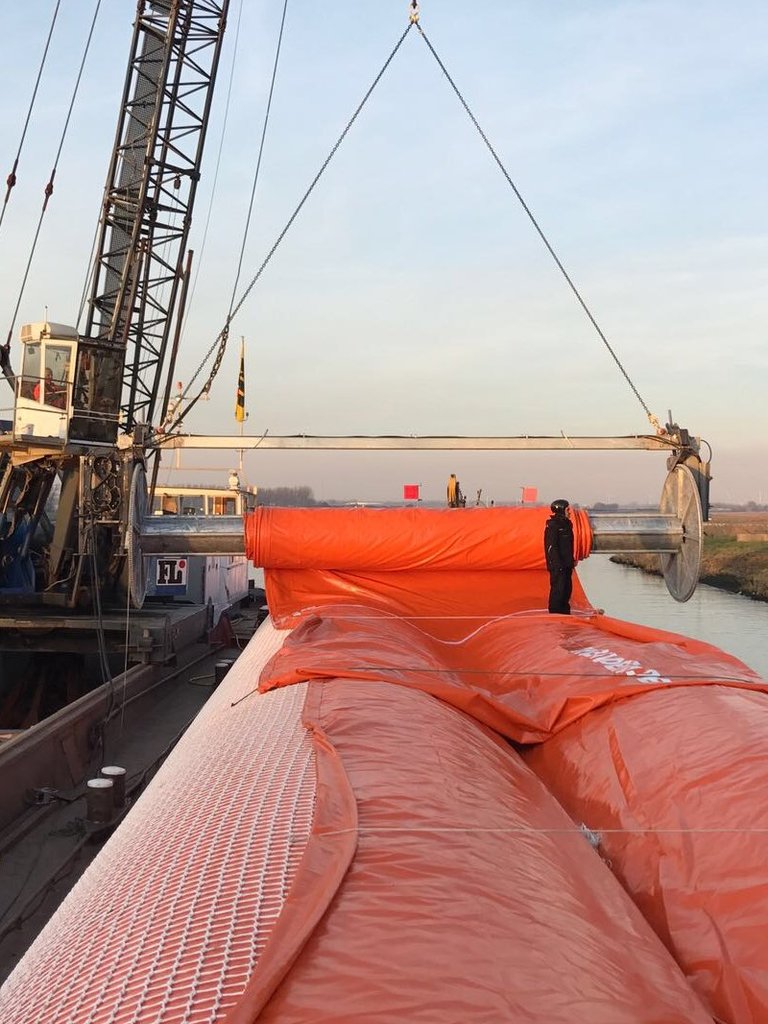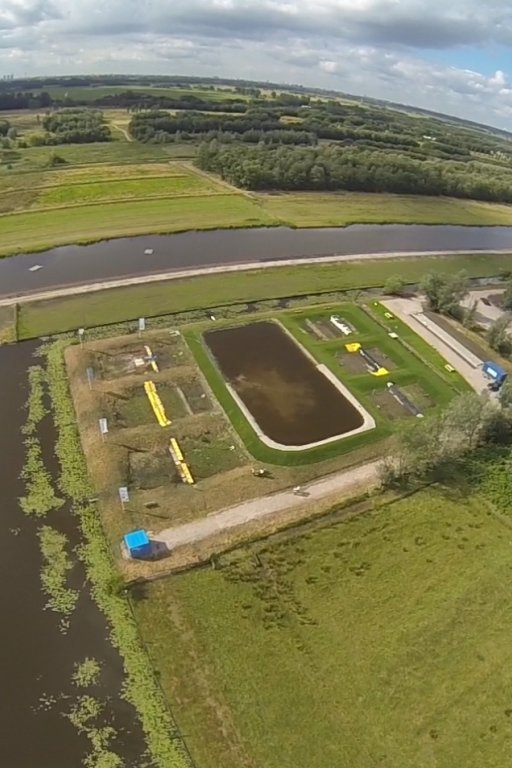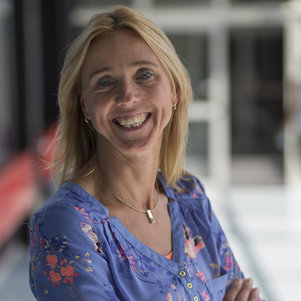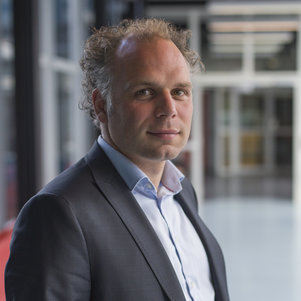
Performing under (water) pressure
May 2018 - By: Inge Snijder
Amidst dense fog, an inland navigation vessel crashed into the weir on the River Meuse at Grave. As a result, the water level in the river dropped to a critically low level. Shipping traffic became impossible and the houseboats on the river turned over on their sides. Dirk Bon and Bart Burggraaf from the start-up Mobiele Dijken came to the rescue by quickly installing a temporary dyke. Emergencies such as the one in Grave underline the importance of smart solutions for protection against water-related calamities. VPdelta develops field labs, where start-ups such as Mobiele Dijken can test their solutions.
The temporary dyke in the Meuse was 7 metres wide, 3.5 metres high and 78 metres long, enough to close off the harbour in Gennep. Mobiele Dijken, together with contractor Liebregts, constructed the dyke at the request of the Netherlands Directorate-General for Public Works and Water Management (Rijkswaterstaat). After the installation of the dyke, the water level returned to its original level. As a result, the boats came afloat and could be towed to a safer location. Eventually, the houseboats returned to an upright position after three days.
Gradual increase
Bon explains that it is important to allow the water level to increase gradually: “This prevents the spit of land, which closes off the harbour from the Meuse, from breaking up under the pressure of the water. Since the water level increases gradually, the boats can come afloat in a controlled manner. The first task was to make the temporary dyke high and strong enough to withstand the gradually rising water level. Within four hours, the temporary dyke was ready and Rijkswaterstaat could start pumping extra water into the harbour.”
Stable solution
The mobile dykes are filled with water. Bon explains: “This means that we use water to stem the flow of water. It is possible to set up the temporary dyke with two to four people and we do not need any heavy machinery for water levels up to 150 cm. Curves, height differences and different subsoils exert additional pressure on the dykes. The specially designed net around the water-filled compartments absorbs all that pressure and distributes it evenly.”
Flood Proof Holland
Mobiele Dijken proved that it was possible to quickly create a stable dyke with a good safety margin. The testing of their dyke at the Flood Proof Holland field lab was essential to ensure that they were capable of completing this task properly. Bon: “At Flood Proof Holland, we can simulate a flood in order to test whether the flow of water has been stemmed properly. It’s brilliant that this emergency at the Gennep harbour gave us a chance to prove that our experiences in the VPdelta field lab with our smaller dykes could also be applied to this large dyke.”
More and more parties are realising that experimental living labs such as Flood Proof Holland are relatively safe environments where they can prepare themselves for 'the real job’. This makes experimental living labs an essential part of the innovation chain for making that leap from idea to market introduction.
Project Leader Hans Brinkhof, Rijkswaterstaat

Safe test environments
The Netherlands has many examples of remarkably innovative solutions that contribute to liveable delta areas. Project Leader Hans Brinkhof of Rijkswaterstaat encourages the use of these innovations created by start-ups and small SMEs: “Companies such as Mobiele Dijken should be able to find a broader platform within our organisation.” More and more parties are realising that experimental living labs such as Flood Proof Holland are relatively safe environments where they can prepare themselves for 'the real job’. This makes experimental living labs an essential part of the innovation chain for making that leap from idea to market introduction.
WaterStraat experimental lab
In addition to dykes for protecting the Dutch harbours and coastline against high water, there are many other innovative products that focus on rainwater flooding in cities caused by more extreme weather. For example, water buffers built under houses, smart rainwater containers placed against façades or water storage facilities on roofs. A new experimental living lab - De WaterStraat - has been set up to test these solutions. Government bodies, entrepreneurs and knowledge institutions are working together in this lab to develop practically applicable solutions to make the city future-proof, thereby limiting flooding and damage and optimising quality of life.
We are already seeing the positive effects of collaborating with other entrepreneurs to find solutions for a future-proof city.
Henk Pannekoek, Ecologisch Waterbeheer (EWB)
A sea shell buffer
One of these entrepreneurs is Henk Pannekoek of Ecologisch Waterbeheer (EWB). He has designed an underground system made up of sea shells, which buffers and purifies rainwater from heavy showers: “At WaterStraat, we want to show that our water purification installation can be easily integrated into the existing infrastructure. This can help avoid complicated and costly renovations.” Pannekoek is happy with the new experimental living lab. He continues: “Thanks to WaterStraat, our system has gained the necessary visibility helping us to market our sea shell buffer faster. In addition, it offers us the opportunity to get the operation of our system validated and documented by TU Delft, and to answer any outstanding research questions.”
Collaboration
Apart from research, collaboration is also an important aspect. Pannekoek: “We are already seeing the positive effects of collaborating with other entrepreneurs to find solutions for a future-proof city. On the one hand, this has helped create a market and, on the other hand, it has also helped establish a very tangible link between solutions and innovations in practice, thereby enhancing each other’s added value.” Businesswoman Dorian Hill (Hill Innovation BV) agrees: “The unique thing about WaterStraat is that we address the larger research questions together with other entrepreneurs. Instead of working on our own, we are looking for suitable combinations for linking together multiple innovations. The fact that the research is carried out by specialised scientists makes it objective and interesting.”
WaterStraat
WaterStraat is a new field lab for the development of innovative products to make roads and neighbourhoods more resistant to extreme weather, such as heavy precipitation or drought. This experimental living lab officially opened on 16 May 2018.
We are facing increasingly extreme weather conditions. Longer periods of dry weather alternate with large amounts of rain within a short period of time. During long dry periods, the atmosphere in the city will become stuffy. And during heavy downpours, in combination with the many pavements, asphalting and tiles, the sewer system can no longer handle the vast amounts of water.
This makes the city vulnerable and affects us all: residents, businesses and government bodies. That is why government bodies, entrepreneurs and knowledge institutions are jointly searching for new, practically applicable solutions to make the city future-proof, thereby limiting flooding and damage by water and optimising quality of life. Inhabitants can also make a contribution to changing the design of their living environment.
The Delfland Water Authority, VPdelta and The Green Village have set up WaterStraat for this purpose. This field lab offers the possibility of testing, further developing and demonstrating concepts and products. For example, water buffers built under houses, smart rainwater containers placed against façades or water storage facilities on roofs. Entrepreneurs, researchers and area managers are working together to prepare the city for the future. WaterStraat is located in The Green Village, a Delft University of Technology site.

Bufferblock
Bufferblock is Hill Innovations’ solution for water storage in urban areas. “In many cities, groundwater levels are very high. The concrete Bufferblock can be placed just below the road surface but can still store high volumes of water. Rainwater enters the hollow spaces of the Bufferblocks via water-permeable road paving or storm drains, after which the water infiltrates further into the soil or is drained off. In addition, the block has been made so strong that lorries can still drive over the road with no problems. The combination of capacity, strength and relatively low costs can offer an integral solution for a large urban area.”
By now we have set up experimental living labs in Europe, Asia and Africa for local testing and innovation, adapted to the specific country and its water challenges.
Marjan Kreijns, Programme Director of VPdelta
More effective water management
In addition to promoting more effective water management in our own delta and cities, field labs are also a showcase for other water managers in the Netherlands and beyond. “By now we have set up experimental living labs in Europe, Asia and Africa for local testing and innovation, adapted to the specific country and its water challenges,” says Marjan Kreijns, Programme Director of VPdelta. That’s good news, because it means Bon does not have to limit himself to Dutch disasters.

Marjan Kreijns
VP Delta Programme Director
- +31 (0)6 18635619
- m.s.kreijns@tudelft.nl
-
Valorisation Centre
TU Delft/Delft University of Technology
Van der Burghweg 1
2628 CS Delft
The Netherlands

Ruben Geradts
VP Delta Programme Manager
- +31 (0)6 48261845
- r.p.geradts@tudelft.nl
-
Valorisation Centre
TU Delft/Delft University of Technology
Van der Burghweg 1
2628 CS Delft
The Netherlands